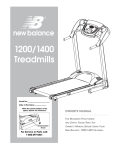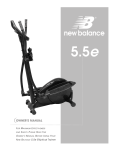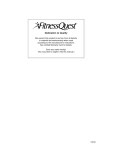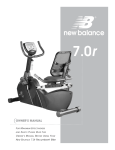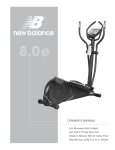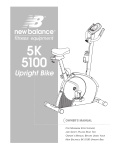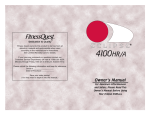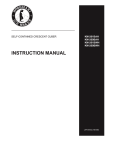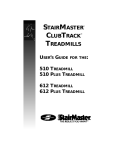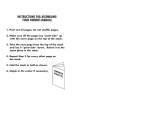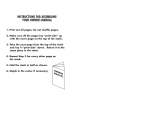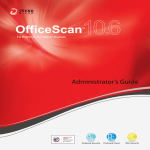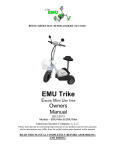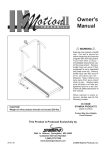Download New Balance 1200 User's Manual
Transcript
1200/1400 and 1500 Treadmills Serial No: _______________________ Date of Purchase: ____________ Write the serial number in the space above for reference. OWNER’S MANUAL F OR M AXIMUM E FFECTIVENESS AND Serial Number Decal For Service or Parts call: 1-800-497-5831 S AFETY, P LEASE R EAD T HIS O WNER ’ S M ANUAL B EFORE U SING Y OUR N EW B ALANCE 1200/1400/1500 T READMILL . TABLE OF CONTENTS Important Safety Instructions ...........................................................2 Introduction/Customer Service Information ..................................3 Unit Warning/Caution Labels and Specifications & Parts.........4-5 Assembly/Setup Instructions .......................................................6-10 Folding and Moving Your Treadmill for Storage .....................11-12 Taking Care of Your Treadmill ...................................................13-14 Electronics Operating Instructions for Your Treadmill ..................15 Quick Reference Guide ......................................................16-17 Display Functions & Program Functions - 1200 .................18-19 Display Functions & Program Functions - 1400/1500........20-21 Using The Pulse Function ...........................................................22 Exercise Guidelines .........................................................................23 Knowing the Basics....................................................................23 A Complete Exercise Program............................................23-24 Aerobic Exercise: How Much? How Often? ...........................24 When to Exercise .......................................................................24 Measuring Your Heart Rate .................................................24-25 Clothing ......................................................................................25 Tips to Keep You Going.............................................................25 Heart Rate Target Zone Chart..................................................26 Warm Up & Cool Down Stretches ...........................................27-28 Troubleshooting Guide ...................................................................29 Workout Progress Charts ................................................................30 Parts List 1200/1400 and 1500 ........................................................31 Exploded View 1200/1400 ..............................................................32 Exploded View 1500 ............................................Inside Back Cover ©2005 and ©2006 Fitness Quest Inc. All rights reserved. Made in China. Fitness Quest ® is a registered trademark of Fitness Quest Inc. New Balance® and NB® logo are registered trademarks of New Balance Athletic Shoe Inc. Fitness Quest Inc. is the exclusive licensee of New Balance Athletic Shoe Inc. No part of this booklet may be reproduced or utilized in any form or by any means electronic, mechanical or otherwise without the express written consent of the copyright holder. 8/22/06 IMPORTANT SAFETY INSTRUCTIONS Read all instructions before using this equipment. – THIS EQUIPMENT IS FOR CONSUMER USAGE ONLY – CAUTION: Exercise of a strenuous nature, as is customarily done on this equipment, should not be undertaken without first consulting a physician. No specific health claims are made or implied as they relate to the equipment. 1) Before starting this or any other exercise program, consult your physician, who can assist you in determining the target heart rate zone appropriate for your age and physical condition. Certain exercise programs or types of equipment may not be appropriate for all people. This is especially important for people over the age of 35, pregnant women, or those with pre-existing health problems or balance impairments. 2) Monitor your heart rate while you exercise and keep your estimated pulse rate within your target heart rate zone. Follow the instructions on pages 24 and 25 in this manual regarding heart rate monitoring and how to determine your appropriate target heart rate zone. When used properly, the heart rate pulse sensors and display monitor provide a reasonably accurate estimate of your actual heart rate. This estimate is not exact and persons with medical conditions and/or a specific need for accurate heart rate monitoring should not rely on the estimations provided. 3) Warm up before any exercise program by doing 5-10 minutes of aerobic activity, followed by stretching. 4) Inspect the equipment. Before EACH use, a complete visual inspection, and test of the features and functions of the assembled equipment is required. Do not use equipment if you detect any incorrect, worn or loose components. NEVER operate the equipment if the equipment is not functioning properly. 5) Do not wear loose or dangling clothing while using the equipment. Wear comfortable clothes that allow freedom of movement. 6) Wear comfortable shoes made of good support with rubberized sole. 7) Breathe naturally, never holding your breath during an exercise. 8) Avoid over training. You should be able to carry on a conversation while exercising. 9) After an exercise session, cool down with slow walking and stretching. 2 10) This equipment should not be used by or near children. 11) Handicapped or disabled people must have medical approval before using this equipment and should be under close supervision when using any exercise equipment. 12) If you are taking medication which may affect your heart rate, a physician's advice is absolutely essential. 13) Use this equipment only for its intended use as described in this manual. Do not use attachments not recommended by the manufacturer. 14) Only one person at a time should use this equipment. 15) Do not put hands, feet, or any foreign objects on or near this equipment when in use by others. 16) Always use this equipment on a level surface. 17) Care should be taken when mounting or dismounting the equipment. Do not stand on the Walking Belt while starting the Treadmill. Straddle the Belt and stand on the plastic Foot Rails. 18) Start exercise slowly and gradually increase the amount of resistance. 19) If the user experiences dizziness, nausea, chest pain, or any other abnormal symptoms, stop exercise at once and consult a physician immediately. 20) Use caution not to pinch fingers or hands in moving parts when using the equipment. 21) Risk of electrical shock. This equipment is to be used only indoors and in a dry location. 22) Have plenty of clearance behind and in front of your Treadmill. It is important to keep children, pets, furniture and other objects out of the way when using your Treadmill. You should have a minimum of 4 feet of clearance both in front of and behind your Treadmill and a minimum of 2 feet of clearance on both sides of the Treadmill. KEEP THESE INSTRUCTIONS INTRODUCTION CONGRATULATIONS ON PURCHASING YOUR NEW BALANCE TREADMILL With this product in your home, you have everything you need to start your own workout program to tone and firm the major muscle groups of your lower body. This is vital for all of us, regardless of age, sex, or fitness level, and regardless of whether your primary goal is toning, health maintenance, or more energy for daily activities. Proper exercise, including a low fat diet, strength training and aerobic exercise, tones and conditions the muscles we use every day to stand, walk, lift and turn. It can actually transform our body composition by reducing body fat and increasing the proportion of lean muscle in our bodies. Using the treadmill will help in reducing body fat and increasing cardiovascular endurance. Be sure to read through this Owner’s Manual carefully. It is the authoritative source of information about your New Balance Treadmill. Retain this manual for future reference. COMMENTS OR QUESTIONS ORDERING REPLACEMENT PARTS Dear Customer, When ordering parts, please contact our Parts Department, toll free at 1-800-497-5831, Monday through Friday, 8:30am to 8:00pm, EST. Congratulations on your purchase of the New Balance Treadmill. We’re sure that you will be completely satisfied with the product and we invite your comments so that we can hear about your success. Please write or call our Customer Service Specialists at the address or phone number listed below, or contact us on our web site or email us with any comments or questions you may have. NEW BALANCE 1200/1400/1500 Treadmill Customer Service Department 1400 Raff Road SW, Canton OH 44750-0001 1-800-292-5009, Monday through Friday 8:30am to 8:00pm, Eastern Standard Time Please do not call the above number for Parts. See Ordering Replacement Parts section to the right. IMPORTANT: You must have your serial number and this manual ready when calling for parts. Serial #: ____________________________ Please also provide the following information: 1) Name, Mailing Address and Telephone Number 2) Date of Purchase 3) Where Product was Purchased (Name of Retail Store, City) 4) Model Number (NBT1200-2, NBT1400-2, NBT1500-2) 5) Part Order Number and Description Email: [email protected] www.newbalancefitness.com All details depicted in this Owner’s Manual, and of the product itself, are subject to change without notice. 3 UNIT WARNING/CAUTION LABELS AND SPECIFICATIONS & PARTS Important: See below for placement of the following warning/caution labels on your Treadmill. WARNING LABEL 1 WARNING LABEL 2 WARNING WARNING FAILURE TO READ AND FOLLOW THE SAFETY INSTRUCTIONS STATED IN THE OWNER’S MANUAL MAY RESULT IN POSSIBLE SERIOUS INJURY OR DEATH. KEEP CHILDREN AWAY. MAXIMUM USER WEIGHT 275/300 LBS. REPLACE THIS LABEL IF DAMAGED, ILLEGIBLE OR REMOVED. CLASS HC. RISK OF ELECTRICAL SHOCK. THIS UNIT IS TO BE USED ONLY INDOORS AND IN A DRY LOCATION. Computer Left Console • • Console Base • • • WARNING LABEL 3 • WARNING Hand Grip CRUSH HAZARD KEEP HANDS CLEAR OF DECK. FAILURE TO DO SO COULD RESULT IN CRUSHED HANDS. Pulse Sensors • • Safety Key FRONT WARNING LABEL 1 WARNING LABEL 2 Upright • Foot Rail • Rear End Cap Side Cap • • • Walking Deck Belt Adjustment Knob • • Suspension Wheel • • Walking Belt • Power Cord Front Motor Cover WARNING LABEL 3 REAR New Balance 1200/1400/1500 Specifications: Approximate: 1200/ 1400 – Length: 76-3/4” Width: 34-3/4” Height: 53-3/4” 1500 – Length: 76-3/4” Width: 32-3/4” Height: 53-3/4” Product Weight: 230 lbs. Maximum User Weight: 1200 - 275 lbs. 1400 - 300 lbs. 1500 - 300 lbs. 4 • Right Console Pulse Sensors ALWAYS UNPLUG THE POWER CORD IMMEDIATELY AFTER USE. Fan WARNING LABEL 4 WARNING CRUSH HAZARD. KEEP HANDS AND FEET CLEAR DURING FOLDING. FAILURE TO DO SO COULD RESULT IN CRUSHED HANDS AND FEET. WARNING LABEL 5 WARNING LABEL 5 safety switch on/off switch WARNING ALWAYS UNPLUG THE POWER CORD IMMEDIATELY AFTER USE. WARNING LABEL 4 power cord CAUTION LABEL 10 CAUTION WARNING LABEL 6 BEFORE FOLDING THE TREADMILL, DECREASE INCLINE TO "0" LEVEL. FAILURE TO DO SO MAY RESULT IN SERIOUS DAMAGE TO TREADMILL AND VOID WARRANTY. WARNING After folding the deck, push and turn the knob clockwise on the latch to lock the deck into place. Failure to lock the deck into place may cause the deck to fall suddenly resulting in serious injury. Before lowering the deck from its folded position, turn the knob counter clockwise and pull the knob on the latch to unlock and release the deck. Slowly lower the deck to the floor and keep your hands and feet clear to avoid crushing or other serious injury. CAUTION LABEL WARNING LABEL 6 5 ASSEMBLY/SETUP INSTRUCTIONS WARNING DO NOT MOVE TREADMILL OUT OF THE BOX UNTIL UNIT IS ASSEMBLED. COLLAPSE BOX BOTTOM AND LAY SIDES DOWN BEFORE ASSEMBLY. WHEN MOVING ASSEMBLED TREADMILL OUT OF THE BOX, MOVE IT OUT OF THE BOX ON ITS WHEELS WHILE THE DECK IS IN THE FOLDED AND LOCKED POSITION. For Maximum Effectiveness and Safety, Please Read This Owner’s Manual Before Assembling or Using Your New Balance 1200/1400/1500 Treadmill. NOTE: All location references, such as front, rear, left or right, made in these instructions are from the user position – on the Treadmill facing the Console. – Console may vary per model – FAILURE TO FOLLOW THIS PROCEDURE MAY RESULT IN SERIOUS INJURY. Parts Box Tools Required: (included) Allen Wrench Multi Hex Tool with Phillips Screwdriver Fastener Pack power cord allen wrench M8 x 20mm allen bolt (6) side cap (2) M8 washer (2) multi hex tool with phillips screwdriver FOR 1500 UNIT ONLY M8 curved washer (4) M4 x 6mm phillips screw (6) cup holders (2) 6 safety key Note: We recommend setting up the unit in the area where it will be used. Remove Box Top. Collapse Box Bottom and leave unit in box to assemble. STEP 1 - Upright Assembly M8 curved washer a) Stand on Walking Belt and grip the uprights and slowly raise them into the assembled position. Secure the right side with (2) M8 x 20mm Allen Bolts (1) M8 Washer and (1) M8 Curved Washer at the bottom of the right Upright as shown in Figure 1. Repeat on other side. b) Use the Allen Wrench provided to tighten. M8 washer upright walking belt M8 x 20mm allen bolt RIGHT SIDE Figure 1 - Install Uprights console base assembly STEP 2 - Console Base Assembly Note: To assure Console Base Assembly does not fall, hold onto Hand Grips while assembling. a) Make sure the wires are connected on the right side. See Figure 2a. b) While standing on the Walking Belt put the Console Base Assembly in the user position by pivoting it carefully down. See Figure 2b. Note: During assembly, DO NOT PINCH WIRES when the Console is folded down and secured to the Upright. M8 curved c) Attach the Console Base Assembly washer to the Uprights by using an M8 x 20mm Allen Bolt and M8 x 20mm allen bolt M8 Curved Washer. Repeat on other side. Tighten with Allen Wrench provided. See Figure 2c. 2b hand grip 2a upright 2c Figure 2 - Install Console Base 7 STEP 3 – Side Cap Assembly a) Attach Side Cap with (3) M4 x 6mm Phillips Screws at the bottom of the Upright. Repeat on other side. b) Use the Multi Hex Tool with Phillips Screwdriver provided to tighten. upright M4 x 6mm phillips screws Figure 3 - Install Side Caps side cap FOR 1500 UNITS ONLY STEP 4 – Adding Cup Holders to the Console Base Assembly Insert Cup Holders into the two holes provided. Please make sure the taller side of the Cup Holder is facing away from the Walking Belt. Assembly is now complete. IMPORTANT: Follow the “Setting Up Treadmill for Use” instructions on the next two pages to move the treadmill off the shipping carton so you may begin your workout. 8 SETTING UP TREADMILL FOR USE STEP 2 STEP 1 1200/1400 UNITS knob locking indicator Folding the Treadmill to allow removal of the shipping box. After assembly is complete, you must fold and move the Treadmill to remove the box. To fold the Treadmill, raise the Deck. Secure the Deck in the upright position by pushing the Knob in while rotating it clockwise until the Locking Indicator is fully visible. Moving the Treadmill (in folded position) Hold the Hand Grips to move the Treadmill forward or backward off of the box. The Treadmill comes with Wheels for easy portability. DO NOT TIP the Treadmill. STEP 3 1200/1400 UNITS 1500 UNIT locking indicator not visable WARNING CRUSH HAZARD KEEP HANDS CLEAR OF DECK. FAILURE TO DO SO COULD RESULT IN CRUSHED HANDS. Lowering the Walking Deck Folding the Treadmill to allow removal of the shipping box. After assembly is complete, you must fold and move the Treadmill to remove the box. To fold the Treadmill , raise the deck. Secure the Deck in the upright position by lowering the latch. It will snap on the handle, and prevent the Deck from lowering itself. Once the Treadmill is in the desired place, lower the Deck by pushing in and turn the Knob counterclockwise until the Locking Indicator is not visible and the Deck is released. NOTICE: This Treadmill has a built-in safety feature to help the Deck lower slowly when unfolding. Please make sure there are no children or other things under the Deck when you lower it. (Continued on next page) 9 STEP 3 Continued 1500 UNIT CAUTION TO REDUCE THE RISK OF DAMAGING ELECTRICAL PARTS TO YOUR TREADMILL, WE STRONGLY RECOMMEND THAT YOU PLUG YOUR TREADMILL INTO A DEDICATED 20 AMP OUTLET, WITHOUT THE USE OF AN ADDITIONAL EXTENSION CORD. PLEASE NOTE THAT THIS TREADMILL IS NOT COMPATIBLE WITH GFCI-EQUIPPED OUTLETS. IF YOUR TREADMILL HAS BEEN EXPOSED TO COLDER TEMPERATURES, WE RECOMMEND THAT THE TREADMILL IS WARMED UP TO ROOM TEMPERATURE BEFORE FIRST TIME USE. FAILURE TO DO SO MAY CAUSE ELECTRONIC FAILURE. on/off switch power cord Lowering the Walking Deck Once the Treadmill is in the desired place, lift the Latch from the Hand Grip of the Treadmill. Then lightly press down to activate the lowering action of the Treadmill. NOTICE: This Treadmill has a built-in safety feature to help the Deck lower slowly when unfolding. Please make sure there are no children or other things under the Deck when you lower it. STEP 410 – Power Cord Assembly Attach Power Cord to Front Motor Cover and plug unit cord into a dedicated outlet. STEP 5 – Turning On the Treadmill Turn the ON/OFF switch to the ON position. ASSEMBLY AND SETUP ARE NOW COMPLETE. IMPORTANT: Please read this owner’s manual before beginning your workout for important instructions on how to use your Treadmill. 10 FOLDING AND MOVING YOUR TREADMILL FOR STORAGE 1200/1400 UNITS 1500 UNIT knob locking indicator TO FOLD THE TREADMILL TO FOLD THE TREADMILL You may fold the Treadmill into the upright position for storage. You may fold the Treadmill into the upright position for storage. CAUTION BEFORE FOLDING THE TREADMILL, DECREASE INCLINE TO "0" LEVEL. FAILURE TO DO SO MAY RESULT IN SERIOUS DAMAGE TO TREADMILL AND VOID WARRANTY. NOTE: Make sure the Treadmill's elevation is at the lowest position. Press the Incline - Key until Incline is at “0” level. If the elevation is not at the lowest position, it would cause damage to the mechanism. TURN OFF AND UNPLUG FIRST! To fold the Treadmill, raise the Deck. Secure the Deck in the upright position by pushing the Knob in while rotating it clockwise until the Locking Indicator is fully visible. CAUTION BEFORE FOLDING THE TREADMILL, DECREASE INCLINE TO "0" LEVEL. FAILURE TO DO SO MAY RESULT IN SERIOUS DAMAGE TO TREADMILL AND VOID WARRANTY. NOTE: Make sure the Treadmill's elevation is at the lowest position. Press the Incline - Key until Incline is at “0” level. If the elevation is not at the lowest position, it would cause damage to the mechanism. TURN OFF AND UNPLUG FIRST! To fold the Treadmill, raise the Deck. Secure the Deck in the upright position by lowering the Latch. It will snap on the Hand Grip, and prevent the Deck from lowering itself. 11 1200/1400 UNITS 1500 UNIT locking indicator not visable WARNING CRUSH HAZARD KEEP HANDS CLEAR OF DECK. FAILURE TO DO SO COULD RESULT IN CRUSHED HANDS. To Lower the Treadmill To Lower the Treadmill To lower the Deck, push in and turn the Knob counter-clockwise until the Locking Indicator is not visible and the Deck is released. NOTICE: This Treadmill has a built-in safety feature to help the Deck lower slowly when unfolding. Please make sure there are no children or other things under the Deck when you lower it. To lower the Deck, lift the Latch from the Hand Grip of the Treadmill. Then lightly press down to activate the lowering action of the Treadmill. NOTICE: This Treadmill has a built-in safety feature to help the Deck lower slowly when unfolding. Please make sure there are no children or other things under the Deck when you lower it. TO MOVE THE TREADMILL (in folded position) Always make sure the Treadmill is turned off and unplugged first! Hold the Hand Grips to move the Treadmill forward or backward. The Treadmill comes with Wheels for easy portability. DO NOT TIP the Treadmill. 12 TAKING CARE OF YOUR TREADMILL WARNING: Always turn off and unplug the Treadmill from the electrical outlet before moving, cleaning, lubricating, or servicing the Treadmill. Note: The Treadmill MUST be placed on a level surface only. If the Treadmill is not level, the belt will continuously slip to the low side of the Treadmill. CAUTION: DO NOT USE Treadmill if it is not on a level surface. Have plenty of clearance behind and in front of your Treadmill. It is important to keep children, pets, furniture and other objects out of the way when using your Treadmill. You should have a minimum of 4 feet of clearance both in front of and behind your Treadmill and a minimum of 2 feet of clearance on both sides of the Treadmill. Worn or damaged components should be replaced immediately. Do not use the Treadmill if it is not working properly. Only manufactured-supplied or approved components shall be used to maintain and repair the Treadmill. It is the sole responsibility of the user/owner to ensure that regular maintenance is performed. turn clockwise. Turn on the Treadmill and check the tension. If it needs additional tension, continue to tighten one turn at a time until the Belt is no longer slipping. Be sure to adjust both sides equally to insure correct Belt alignment. WALKING BELT CENTERING The Walking Belt may occasionally need to be centered. Your Treadmill has sight indexes that aid in keeping the Walking Belt centered. First, be sure the Belt is tensioned properly. Then, run the Treadmill at 4 mph. It is easiest to use only the left Adjustment Knob in making Walking Belt centering adjustments. sight index (preset at 2) WALKING BELT TENSION Walking Belts tend to stretch slightly with use. The Walking Belt may occasionally need to be tightened. If the Walking Belt is too loose, you may find the Belt stops or hesitates while running or walking. However, it is very important not to over-tighten the Walking Belt as it will damage the Motor, Rollers, and Electrical Components. If the Walking Belt has moved to the right, turn the Left Adjustment Knob a quarter turn to the left. Let the Treadmill run about 30 seconds, and if the Belt does not move, repeat. When properly tensioned, you should be able to lift the side of the Belt about 2-3 inches, or you should be able to fit three fingers under the edge of the Belt. This should be done on either side of the Belt in the center of the Deck. belt If the Walking Belt has moved to the left, turn the Left Adjustment Knob a quarter turn to the right. Let the Treadmill run about 30 seconds, and if the Belt does not move, repeat. foot rail To tighten the Belt, with the Treadmill off, turn the Left Knob at the end of the Treadmill one full turn clockwise, and then turn the Right Knob one full 13 WARNING: Always turn off and unplug the Treadmill from the electrical outlet before cleaning, lubricating, or servicing the Treadmill. CLEANING Keeping the Treadmill clean will prolong the life of the Treadmill and improve performance. WALKING BELT AND DECK LUBRICATION Your Treadmill Belt has been lubricated at the factory, but periodic lubrication will extend the life of your Treadmill Belt, Board, and Electrical Components. We recommend the following lubrication schedule based on weekly usage: Regularly dust the unit, especially the exposed part of the Deck between the Belt and the Side Rails. For best performance, we recommend your Treadmill be placed on a Treadmill Mat. A Treadmill Mat will help to keep dust debris away from your Treadmill's electrical components. Clean the top of the Belt with a damp cloth. Be careful to keep liquid away from inside the frame or underneath the Belt. 5+ hours per week Monthly 3 - 5 hours per week Every three months 0 - 3 hours per week Every six months LUBRICATION APPLICATION 1. Put a liberal quantity of lubricant onto foam side of the Applicator Wand. Apply lubricant evenly across the foam pad. foam pad At least once a year remove the Motor Cover and vacuum under the Motor Cover. To remove the cover: After turning off and unplugging the Treadmill, loosen the screws (you do not have to remove the screws) on each side (2) and in the front (2) of the Motor Cover and carefully lift the cover off. Be careful, especially around the wiring on the lower board. WARNING: Always turn off and unplug the Treadmill from the electrical outlet before removing the Motor Cover. motor cover applicator wand 2. Insert the Applicator Wand into the lubrication port on the right hand side of the Treadmill, under the Walking Belt with the lubricated side of the Applicator Wand up, against the Belt. Slide it completely across the Walking Deck into the lubrication port on the left side of the Treadmill. NOTE: Make sure the Applicator Wand is securely in the left side lubrication port. lubrication port screw (2) LEFT SIDE safety switch on/off switch RIGHT SIDE power cord applicator wand motor cover 14 screw (2 each side) 3. Start the Treadmill Belt and set the speed at 1.0 mph. Let the Belt run for about 45 seconds in order to spread the lubrication on the underneath side of the belt. 4. Place Applicator Wand in plastic sleeve to retain moisture. 1200 1400/1500 Electronics Operating Instructions For Your Treadmill SAFETY TIPS: • • • Practice mounting and dismounting your Treadmill before beginning your workout. Attach the Safety Key to the Computer (the Treadmill will not operate without the Safety Key). Clip the other end of the Safety Key to your clothing before exercising to ensure the Treadmill will stop if the user accidentally walks off the Treadmill. If the user falls off the Treadmill, the Safety Key will come off the Computer and the Treadmill will stop at once to avoid further injury. • • Do not stand on the Walking Belt while starting the Treadmill. Straddle the Belt and stand on the plastic Foot Rails. The Treadmill will start at 0.5mph after a 3,2,1 countdown. If you are a new user, stay at a slow speed and hold onto the Hand Grips until you become comfortable. 15 16 Displays the preset or user programs. Also will display the elevation and elevation gain values for three seconds during workout. When power is off, press for 2 seconds to change from miles to kilometers. SELECT Increases or decreases the INCLINE when pressed. START/STOP KEY POWER KEY Pressing this confirms the selection of a program. Also confirms the speed and incline values during the setting of a user program. The Computer can be operated only with the Safety Key attached to the Treadmill. The Computer shuts off and the Treadmill stops when this key is removed. SAFETY KEY Pressing this starts and stops the Treadmill Belt. safety key Pressing this key brings power to the Treadmill and must be pressed before any other key. Increases or decreases the SPEED when pressed. Pressing once increases or decreases the speed 0.1 mph. Pressing and holding for two seconds will increase or decrease the speed faster. + or - KEYS 1-10 MPH Pressing these keys gradually changes the SPEED to that value. 1-12 % Pressing these keys slowly changes the Incline to that value. + or - KEYS SPEED QUICK KEYS ENTER FAN Turns fan on/off. Press this key to put the fan on low speed, again to go to high speed and again to turn the fan off. INCLINE QUICK KEYS Pressing these selects a program. Press Power, then select Program, hit Enter, then Start. PROGRAM KEYS QUICK REFERENCE GUIDE 1200 1% Displays the preset or user programs. Also will display the elevation and elevation gain values for three seconds during workout. When power is off, press for 2 seconds to change from miles to kilometers. 3% 2% WALKING FAT BURN PIKES PEAK MTN. PASS HILL WALK PROGRAMS SELECT INCLINE + - ENTER ENTER SPEED HI + - START/STOP KEY SAFETY KEY FAN MPH 3 Pressing this key brings power to the Treadmill and must be pressed before any other key. safety key MPH 5 + or - KEYS 1-11 MPH Pressing essing these keys gradually changes the SPEED to that value. SPEED QUICK KEYS Increases or decreases the SPEED when pressed. Pressing once increases or decreases the speed 0.1 mph. Pressing and holding for two seconds will increase or decrease the speed faster. MPH MPH 7 MPH 8 MPH 9 MPH 10 6 MPH 4 POWER KEY MPH 1 MPH 2 USER 2 USER 1 CALORIES DISTANCE JOGGING PROGRAMS MPH 11 SPEED Turns fan on/off. Press this key to turn the fan on and press again to turn fan off. Pressing this starts and stops the Treadmill Belt. The Computer can be operated only with the Safety Key attached to the Treadmill. The Computer shuts off and the Treadmill stops when this key is removed. PLACE SAFETY KEY HERE Pressing these selects a program. Press Power, then select Program, hit Enter, then Start. PROGRAM KEYS Pressing this confirms the selection of a program. Also confirms the speed and incline values during the setting of a user program. INCLINE 4% 5% 6% SELECT Increases or decreases the INCLINE when pressed. + or - KEYS 1-12 % Pressing these keys slowly changes the Incline to that value. INCLINE QUICK KEYS 7% 8% 9% 10% 11% 12% QUICK REFERENCE GUIDE 1400/1500 17 DISPLAY FUNCTION 1200 Please read carefully before using the Treadmill. INCLINE/PULSE: Displays pulse rate except when elevation is changed or SELECT key is pressed. To get a pulse rate, place both of your hands on the Pulse Grip Bars. It is recommended to straddle the Walking Belt to get an accurate reading. If you are walking or jogging, it is difficult for the Computer to accurately read your pulse rate. (See page 22 for more details.) TIME: Shows workout Time. Time begins at 00:00 and counts up. The maximum time is 99:59. When the Safety Key is first attached to the Computer, this display shows the accumulated Distance (odometer) for one second. SPEED: Displays the Speed the Treadmill Belt is moving. DISTANCE: Displays the Distance, in miles or kilometers, the Treadmill Belt has gone on the current workout. DOT MATRIX: The 8 x 10 dot matrix reflects Incline on the Elevation Programs (Programs 1-4) and Speed on the Speed Programs (Programs 5-6) and the User Programs. In the Manual Mode, the dot matrix displays a 1/4 mile running track. Manual Mode shown above. CALORIES/ELEVATION GAIN: Displays Calories consumed. To display Elevation, in feet, the user has climbed during the current workout, press SELECT and the value will display for three seconds. The Calorie Calculation is based on a 150 pound person. PROGRAM FUNCTION 1200 PROGRAM 6 PROGRAM 3 PROGRAM 4 PROGRAM 1 U1 FAT BURN HILL WALK PROGRAM 5 PROGRAM 2 MOUNTAIN PASS USER 1 U2 WALKING Odometer: An Odometer showing accumulated distance will appear in the Time window for one second when the Safety Key is placed on the Computer. Time-Out: If the Treadmill is turned on, and the Belt is not moving, the Computer will shut-off after five minutes. 18 JOGGING PIKES PEAK MANUAL USER 2 Re-Start: If the Treadmill is stopped during use, when the START button is pressed again, the Treadmill will ramp-up the speed to where it was stopped. If the Treadmill is stopped for 5 minutes or more, POWER is lost and the Treadmill will have to be re-started. 1200 PROGRAMS MANUAL MODE: If you elect to operate the Treadmill in Manual Mode, press START. The Treadmill will start at 0.5mph after a 3,2,1 countdown. 4. Fat Burn: This is an interval elevation program where the elevation alternates between 0% and 5%. The user controls the speed. PROGRAM MODE: After pressing POWER, press the desired program using the program Quick Keys or press SELECT to choose one of the programs. Note: The program layout appears in the dot matrix display. Press ENTER to verify the selection. 5. Walking: This is a speed program that varies between 2.5mph and 3.3mph. This is an excellent program for intermediate walkers. The user controls the elevation. Press START to begin the program. All programs have ten segments. The program will repeat after the ten segments until the user presses STOP. An explanation of the programs follow: 1. Hill Walk: This is an elevation program that goes from 0% to 3% grade. The speed is controlled by the user and the Treadmill will start at 0.5mph. Each minute, the elevation changes. 2. Mountain Pass: This is an elevation program that goes from 0% to 5% grade. The speed is controlled by the user. 3. Pikes Peak: This is a challenging elevation program that goes from 0% to 7% grade. The speed is controlled by the user. 6. Jogging: This is a speed program that varies the speed between 4.0mph and 4.8mph. This is a good program for beginner joggers and very fast walkers. The user controls the elevation. 7. User Programs: After selecting one of the user programs, press ENTER to confirm. Press ENTER again and adjust the Speed and Incline for segment one and press ENTER. Continue to adjust the speed and incline for each segment and press ENTER. Press START to begin the workout. If a speed or incline value is changed during usage, the Computer will store the value of the speed and incline at the end of each segment and will retain these values. 19 1400 1500 OPERATION INSTRUCTIONS Please read carefully before using the Treadmill. DISPLAYS INCLINE/PULSE: Displays pulse rate except when elevation is changed or SELECT key is pressed. To get a pulse rate, place both of your hands on the Pulse Grip Bars. It is recommended to straddle the Walking Belt to get an accurate reading. If you are walking or jogging, it is difficult for the Computer to accurately read your pulse rate. (See page 22 for more details.) TIME: Shows workout Time. Time begins at 00:00 and counts up. The maximum time is 99:59. When the Safety Key is first attached to the Computer, this display shows the accumulated distance (odometer) for one second. SPEED: Displays the Speed the Treadmill Belt is moving. DISTANCE: Displays the Distance, in miles or kilometers, the Treadmill Belt has gone on the current workout. CALORIES/ELEVATION GAIN: Displays Calories consumed. To display Elevation, in feet, the user has climbed during the current workout, press SELECT and the value will display for three seconds. The Calorie Calculation is based on a 150 pound person. DOT MATRIX: The 8 x 10 dot matrix reflects Incline on the Elevation Programs (Programs 1-4) and Speed on the Speed Programs (Programs 5-6) and the User Programs. In the Manual Mode, the dot matrix displays a 1/4 mile running track. Manual Mode shown above. PROGRAM 5 MOUNTAIN PASS USER 1 U2 PROGRAM 7 FAT BURN HILL WALK PROGRAM 2 JOGGING PIKES PEAK PROGRAM 4 PROGRAM 1 U1 PROGRAM 6 PROGRAM 3 MANUAL TARGET DISTANCE USER 2 PROGRAM 8 WALKING Odometer: An Odometer showing accumulated distance will appear in the Time window for one second when the Safety Key is placed on the Computer. Time-Out: If the Treadmill is turned on, and the Belt is not moving, the Computer will shut-off after five minutes. 20 1500 PROGRAM FUNCTION 1400 TARGET CALORIES Re-Start: If the Treadmill is stopped during use, when the START button is pressed again, the Treadmill will ramp-up the speed to where it was stopped. If the Treadmill is stopped for 5 minutes or more, POWER is lost and the Treadmill will have to be re-started. 1400/1500 PROGRAMS MANUAL MODE: If you elect to operate the Treadmill in Manual Mode, press START. The Treadmill will start at 0.5mph after a 3,2,1 countdown. PROGRAM MODE: After pressing POWER, press the desired program using the program Quick Keys or press SELECT to choose one of the programs. Note: The program layout appears in the dot matrix display. Press ENTER to verify the selection. Press START to begin the program. All programs have ten segments. The program will repeat after the ten segments until the user presses STOP. An explanation of the programs follow: 1. Hill Walk: This is an elevation program that goes from 0% to 3% grade. The speed is controlled by the user and the Treadmill will start at 0.5mph. Each minute, the elevation changes. 2. Mountain Pass: This is an elevation program that goes from 0% to 5% grade. The speed is controlled by the user. 3. Pikes Peak: This is a challenging elevation program that goes from 0% to 7% grade. The speed is controlled by the user. 4. Fat Burn: This is an interval elevation program where the elevation alternates between 0% and 5%. The user controls the speed. 5. Walking: This is a speed program that varies between 2.5mph and 3.3mph. This is an excellent program for intermediate walkers. The user controls the elevation. 6. Jogging: This is a speed program that varies the speed between 4.0mph and 4.8mph. This is a good program for beginner joggers and very fast walkers. The user controls the elevation. 7. Target Distance: This program counts down the distance goal that the user sets before exercising. After confirming the program, the user enters the distance goal using the speed or incline arrow keys. Increments are 0.5 miles. Press ENTER to confirm the distance goal, press START, the Treadmill Belt starts and the user controls the speed and incline. The distance will count down in the distance window. 8. Target Calories: This program counts down the calorie goal that the user sets before exercising. After confirming the program, the user enters the calorie goal using the Speed or Incline arrow keys. Increments are 10 calories. Press ENTER to confirm the calorie goal, press START, the Treadmill starts and the user controls the speed and incline. The calorie goal will count down in the Calories window. 9. User Programs: After selecting one of the user programs, press ENTER to confirm. Press ENTER again and adjust the Speed and Incline for segment one and press ENTER. Continue to adjust the speed and incline for each segment and press ENTER. Press START to begin the workout. If a speed or incline value is changed during usage, the Computer will store the value of the speed and incline at the end of each segment and will retain these values. 21 1200 USING THE PULSE FUNCTION 1400/1500 The Pulse Window on your Computer works in conjunction with the Pulse Sensors found on the Console. When you are ready to read your pulse: 1. Place both hands firmly on the Pulse Sensors. For the most accurate reading, it is important to use both hands. 2. Look at your Pulse Window. The “P” will begin to blink. 3. Your estimated heart rate will appear in the window approximately 6 seconds after you grasp the Pulse Sensors. 4. Refer to the Target Heart Rate Zone Chart found on page 26 of this manual. For additional information about the importance of working within certain heart rate ranges, see pages 24 - 25 – Measuring Your Heart Rate. 5. This estimate is not exact and persons with medical conditions and/or a specific need for accurate heart rate monitoring should not rely on the estimations provided. 22 Pulse Sensors When used properly, the heart rate pulse sensors and display monitor provide a reasonably accurate estimate of your actual heart rate. This estimate is not exact and persons with medical conditions and/or a specific need for accurate heart rate monitoring should not rely on the estimations provided. EXERCISE GUIDELINES IMPORTANT Please review this section before you begin exercising. IMPORTANT: If you are over 35 and have been inactive for several years, you should consult your physician, who may or may not recommend a graded exercise test. If you are just beginning your exercise program, your target heart rate range should be roughly at 60% of your maximum heart rate. As you become more conditioned (or if you are already in good cardiovascular shape) you can increase your target heart rate to 70%-85% of your maximum heart rate. Remember, your target heart rate is only a guide. You should also consult your physician if you have the following: • High blood pressure • High cholesterol • Asthma • Heart trouble • Family history of early stroke or heart attack deaths • Frequent dizzy spells • Extreme breathlessness after mild exertion • Arthritis or other bone problems • Severe muscular, ligament or tendon problems • Other known or suspected disease • If you experience any pain or tightness in your chest, an irregular heartbeat or shortness of breath, stop exercising immediately. Consult your physician before continuing. KNOWING THE BASICS Physical fitness is most easily understood by examining its components, or "parts". There is widespread agreement that these five components comprise the basics of physical training: CARDIORESPIRATORY ENDURANCE – the ability to deliver oxygen and nutrients to tissues, and to remove wastes, over sustained periods of time. Using your Treadmill will improve this. MUSCULAR STRENGTH – the ability of a muscle to exert force for a brief period of time. Upper-body strength, for example, can be measured by various weight-lifting exercises. MUSCULAR ENDURANCE – the ability of a muscle, or a group of muscles, to sustain repeated contractions or to continue applying force against a fixed object. Push ups are often used to test endurance of arm and shoulder muscles. FLEXIBILITY – the ability to move joints and use muscles through their full range of motion. The sitand-reach test is a good measure of flexibility of the lower back and backs of the upper legs. BODY COMPOSITION – often considered a component of fitness. It refers to the makeup of the body in terms of lean mass (muscle, bone, vital tissue and organs) and fat mass. An optimal ratio of fat to lean mass is an indication of fitness, and the right types of exercises will help you decrease body fat and increase or maintain muscle mass. To help track your progress we have provided Workout Progress Chart on page 30. • Pregnant A COMPLETE EXERCISE PROGRAM • Balance impairment How often, how long and how hard you exercise, and what kinds of exercises you do should be determined by what you are trying to accomplish. Your goals, your present fitness level, age, health, skills, interest and convenience are among the factors you should consider. For example, an athlete training for high-level competition would follow a different program than a person whose goals are good health and the ability to meet work and recreational needs. • Taking medications that affect heart rate Your exercise program should include something from each of the four basic fitness components 23 described previously. Each workout should begin with a warm up and end with a cool down. As a general rule, space your workouts throughout the week and avoid consecutive days of hard exercise. Here are the amounts of activity necessary for the average healthy person to maintain a minimum level of overall fitness. Included are some of the popular exercises for each category. WARM UP – 5 -10 minutes of exercise such as walking, slow jogging, knee lifts, arm circles or trunk rotations. Low intensity movements that simulate movements to be used in the activity can also be included in the warm up. MUSCULAR STRENGTH – a minimum of two, 20 minute sessions per week that include exercises for all the major muscle groups. Lifting weights is the most effective way to increase strength. MUSCULAR ENDURANCE – at least three, 30 minute sessions each week that include exercises such as calisthenics, push ups, sit ups, pull ups, and weight training for all the major muscle groups. CARDIORESPIRATORY ENDURANCE – at least three, 20 minute workouts of continuous aerobic exercise each week. Working out on your Treadmill is a good way to obtain this aerobic activity. Other popular aerobic conditioning activities include brisk walking, jogging, swimming, cycling, rope jumping, rowing, cross-country skiing, and some continuous action games like racquetball and handball. FLEXIBILITY – 10 -12 minutes of daily stretching exercises performed slowly, without a bouncing motion. This can be included after a warm up or during a cool down. Refer to pages 27 and 28 for a list of total body stretches. COOL DOWN – a minimum of 5 -10 minutes of slow walking or lower intensity elliptical exercise, combined with stretching. AEROBIC EXERCISE: HOW MUCH? HOW OFTEN? Experts recommend that you do some form of aerobic exercise at least three times a week for a minimum of 20 continuous minutes. Of course, if that is too much, start with a shorter time span and gradually build up to the minimum. Then gradually progress until you are able to work aerobically for 20 - 40 minutes. If you want to lose weight, you may want to do your aerobic workout five times a week. It is important to exercise at an intensity vigorous enough to cause your heart rate and breathing to increase. How hard you should exercise depends to 24 a certain degree on your age, and is determined by measuring your heart rate in beats per minute. Refer to the “Measuring Your Heart Rate” section below and on the following page for more information on how to determine and measure your heart rate. You can do different types of aerobic activities, say walking one day, and use your Treadmill the next. Make sure you choose an activity that can be done regularly, and is enjoyable for you. The important thing to remember is not to skip too many days between workouts or fitness benefits will be lost. If you must lose a few days, gradually work back into your routine. WHEN TO EXERCISE The hour just before the evening meal is a popular time for exercise. The late afternoon workout provides a welcome change of pace at the end of the work day and helps dissolve the day's worries and tensions. Another popular time to work out is early morning, before the work day begins. Advocates of the early start say it makes them more alert and energetic on the job. Among the factors you should consider in developing your workout schedule are personal preference, job and family responsibilities, availability of exercise facilities and weather. It's important to schedule your workouts for a time when there is little chance that you will have to cancel or interrupt them because of other demands on your time. You should not exercise strenuously during extremely hot, humid weather or within two hours after eating. Heat and/or digestion both make heavy demands on the circulatory system, and in combination with exercise can be an over-taxing double load. MEASURING YOUR HEART RATE (see chart on page 26) Heart rate is widely accepted as a good method for measuring intensity during running, swimming, cycling, and other aerobic activities. Exercise that doesn't raise your heart rate to a certain level and keep it there for 20 minutes won't contribute significantly to cardiovascular fitness. The heart rate you should maintain is called your Target Heart Rate. There are several ways of arriving at this figure. One of the simplest is: maximum heart rate (220 - age) x 70%. Thus, the target heart rate for a 40 year-old would be 126. In this example for this 40 year old to get a cardiovascular effect the individual would need to keep their heart rate at or above 126 beats per minute to get a cardiovascular effect. Note: Although 70% was used in this example, the heart rate range needed to achieve results falls between 60% and 85% of your maximum heart rate. If you are just beginning your exercise program, your target heart rate range should be roughly at 60% of your maximum heart rate. As you become more conditioned (or if you are already in good cardiovascular shape) you can increase your target heart rate to 70%-85% of your maximum heart rate. Remember, your target heart rate is only a guide. When checking heart rate during a workout, take your pulse within five seconds after interrupting exercise because it starts to go down once you stop moving. Count pulse for 10 seconds and multiply by six to get the per-minute rate. CLOTHING All exercise clothing should be loose-fitting to permit freedom of movement, and should make the wearer feel comfortable and self-assured. Never wear rubberized or plastic clothing, such garments interfere with the evaporation of perspiration and can cause body temperature to rise to dangerous levels. We recommend wearing a workout shoe with a rubberized sole unless instructed otherwise. TIPS TO KEEP YOU GOING 1. Adopt a specific plan and write it down. 2. Keep setting realistic goals as you go along, and remind yourself of them often. 3. Keep a log to record your progress and make sure to keep it up-to-date. See page 30. Remember, your New Balance Treadmill also comes with pulse sensors located on the Console. 4. Include weight and/or percent body fat measures in your log. Extra pounds can easily creep back. When used properly, the unit pulse sensors can help you to determine your estimated heart rate. To do so: 5. Upgrade your fitness program as you progress. Your Treadmill provides different workout programs to keep your workouts challenging. 1. Push the start button on your Computer. 6. Enlist the support and company of your family and friends. 2. Gently grab both metal pulse sensors on both handlebars. Wait 6 seconds. 3. Your estimated heart rate range will be displayed on screen. Check the chart on the following page to see if you are within your range according to your age. 7. Update others on your successes. 8. Avoid injuries by pacing yourself and including a warm up and cool down period as part of every workout. See page 24. 9. Reward yourself periodically for a job well done! When used properly, the heart rate pulse sensors and display monitor provide a reasonably accurate estimate of your actual heart rate. This estimate is not exact and persons with medical conditions and/or a specific need for accurate heart rate monitoring should not rely on the estimations provided. By using the chart on the next page you can see where your heart rate falls in the minimum and maximum target zones. The above are guidelines, people with any medical limitations should discuss this formula with their physician. 25 HEART RATE TARGET ZONE FOR CARDIOVASCULAR FITNESS TABLE 1 200 195 190 190 185 180 180 175 170 170 165 Heart 160 Rate (Beats/ 150 Min) 140 165 161 160 157 155 153 148 150 144 145 140 Maximum Attainable Heart Rate 140 136 136 133 131 129 130 127 129 123 129 119 120 115 119 112 108 110 100 20 105 25 30 35 40 45 50 55 60 65 70 101 98 75 70% Target 80 Zone AGE (YRS) TABLE 2 Exercise Week 1&2 3&4 5&6 7&8 9 & 10 11 & 12 26 Warm Up Period 5 5 5 5 5 5 min min min min min min THR% Minutes 60-65% 65-70% 70-75% 70-80% 70-85% 70-85% -8 -10 -15 -20 -25 -25 Cool Down Period 5 5 5 5 5 5 min min min min min min Total Time 17 20 25 30 35 35 min min min min min min 85% Target Zone Sessions Per Wk. 3 3 3 3 3 3 Total Time Per Wk. 51 60 75 90 105 105 min min min min min min WARM UP & COOL DOWN STRETCHES Stretches can help improve flexibility and relieve the tightness in muscles that results from repetitive sport movements that require a limited range of motion. 10 to 12 minutes of daily stretching is recommended. This can be done when warming up or cooling down. When performing these stretches, your movements should be slow and smooth, with no bouncing or jerking. Move into the stretch until you feel a slight tension, not pain, in the muscle and hold the stretch for 20 to 30 seconds. Breathe slowly and rhythmically. Be sure not to hold your breath. Remember that all stretches must be done for both sides of your body. 1. Quadriceps Stretch Stand close to a wall, chair or other solid object. Use one hand to assist your balance. Bend the opposite knee and lift your heel towards your buttocks. Reach back and grasp the top of your foot with the same side hand. Keeping your inner thighs close together, slowly pull your foot towards your buttocks until you feel a gentle stretch in the front of your thigh. You do not have to touch your buttocks with your heel. Stop pulling when you feel the stretch. Keep your kneecap pointing straight down and keep your knees close together. (Do not let the lifted knee swing outward.) Hold the stretch for 20 to 30 seconds. Repeat for the other leg. 2. Calf and Achilles Stretch Stand approximately one arms length away from a wall or chair with your feet hip-width apart. Keeping your toes pointed forward, move one leg in close to the chair while extending the other leg behind you. Bending the leg closest to the chair and keeping the other leg straight, place your hands on the chair. Keep the heel of the back leg on the ground and move your hips forward. Slowly lean forward from the ankle, keeping your back leg straight until you feel a stretch in your calf muscles. Hold for 20 to 30 seconds. Repeat for the opposite leg. 3. Overhead/Triceps Stretch Stand with your feet shoulder width apart and your knees slightly bent. Lift one arm overhead and bend your elbow, reaching down behind your head with your hand toward the opposite shoulder blade. Walk your fingertips down your back as far as you can. Hold this position. Reach up with your opposite hand and grasp your flexed elbow. Gently assist the stretch by pulling on the elbow. Hold for 20 to 30 seconds. Repeat for the opposite arm. 27 4. Back Stretch Stand with your legs shoulder width apart and your knees slightly bent. Bend forward from your waist with your arms extending loosely in front of your body. Gently bend from the waist flexing your body as far forward as it will go. Hold for 20 to 30 seconds. Straighten up and repeat. 5. Standing Hamstrings Stretch Stand with your legs hip-width apart. Extend one leg out in front of you and keep that foot flat against the ground. With your hands resting lightly on your thighs, bend your back leg and lean forward slightly from your hips until you feel a stretch in the back of your thigh. Be sure to lean forward from the hip joint rather than bending at your waist. Hold for 20 to 30 seconds. Repeat for the opposite leg. 6. Buttocks, Hips and Abdominal Stretch Lay flat on your back with your hips relaxed against the floor. Bend one leg at the knee. Keeping both shoulders flat on the floor, gently grasp the bent knee with your hands and pull it over your body and towards the ground. You should feel a stretch in your hips, abdominals and lower back. Hold for 20 to 30 seconds and release. Repeat for opposite side. 7. Inner Thigh Stretch Sit on the floor and bend your legs so that the soles of your feet are together. Place your elbows on your knees. Lean forward from the waist and press down lightly on the inside of your knees. You should feel a stretch in the muscles of your inside thigh. Hold for 20 to 30 seconds and release. 8. Arm Pullback Stand with your feet shoulder width apart and toes pointing forward and with your knees slightly bent. Let your arms hang relaxed on either side of your body. Expand your chest and pull your shoulders back. Bend your elbows slightly and clasp your hands behind your back. Slowly straighten your arms as you lift your hands upward. Raise your hands upward until you feel mild tension in your shoulder and chest region. Hold for 20 to 30 seconds. Lower your arms to their original position and bend your elbows. Release your hands and return them to your sides. 28 TROUBLESHOOTING GUIDE PROBLEM CAUSE CORRECTION 1. Not plugged in 2. Not turned on 3. Safety Key not on correctly Treadmill will not start 4. Circuit Breaker opened in home 5. Treadmill Circuit Breaker tripped 1. Plug into three prong grounded outlet 2. Turn on the Main Power, on/off button 3. Put Safety Key on Console where indicated 4. Reset home breaker 5. Reset Treadmill Circuit Breaker (see below) Treadmill Speed Not Correct 1. Treadmill starts at 0.5 calibrated in miles – 0.8 calibrated in Kilometers 1. With Monitor powered off, press & hold the Select button for 4 sec. to adjust reading Treadmill Speed Surges 1. Walking Belt slipping 2. Lubricate Walking Belt 3. Motor Controller not set properly 1. Tighten Walking Belt (see page 13) 2. Lubricate Belt and Deck (see page 14) 3. Call 800-497-5831 for service Treadmill Belt will not move ERR 1 on screen 1. Lost speed input signal 1. Call 800-497-5831 for service Incline will not operate ERR 3 on screen 1. Lost incline signal 1. Remove and replace Safety Key and Treadmill will recalibrate Treadmill Belt Slipping 1. Walking Belt loose 2. Deck needs lubrication 1. Tighten Walking Belt (see page 13) 2. Lubricate Belt and Deck (see page 14) Treadmill Noisy 1. Loose hardware 2. Motor straining 1. Tighten all visible Screws, Nuts, and Bolts 2. Check Belt tension - 3 finger test (see page 13) 3. Adjust Rear Rollers - check for tension (see page 13) 3. Clicking sound - Roller knocking 1. Too much hand movement Inaccurate pulse rate 2. Palms too wet 3. Gripping hand grips too tight 4. Wearing rings Inaccurate heart rate strap 1. Electrical interference 1. Stand on Side Rails to get accurate pulse reading - OR - Must have two hands on grips 2. Dry palms 3. Grip using moderate pressure 4. Remove all rings 1. Keep at least six feet away from Televisions, Computers and Fluorescent Lights CAUTION safety switch on/off switch power cord 10 The Treadmill will shut off when the electricity load is above it’s capacity (example: power surge or storm). To restart the Treadmill, please follow the procedure below: A. Unplug the power cord from the Treadmill’s socket. B. Push in the safety switch. C. Plug the power cord back into the Treadmill’s socket. NOTE: DON'T PUSH IN THE SAFETY SWITCH BEFORE UNPLUGGING THE TREADMILL’S POWER CORD. 29 WORKOUT PROGRESS CHARTS Use the charts below to keep track of your progress over time. Before writing on them, make as many copies as you think you’ll need. We suggest you keep these in a notebook. You will find it both informative and motivational to look back at what you’ve done, and this data will help you to chart future fitness goals as you progress. Every two weeks, measure yourself to rechart your progress. Measuring Sites Waist Abdomen Hips Thighs (L/R) Date Weight Waist Abdomen Hips Thighs Calves Resting Heart Rate Calves (L/R) Date 30 Weight Waist Abdomen Hips Thighs Calves Resting Heart Rate 1200/1400 PARTS LIST ITEM # PART NAME 08 14 15 ARC BRACKET SAFETY KEY LEFT CONSOLE 17 18 20 21 22 22 26 27 29 30 34 35 36 37 38 39 40 41 42 44 45 46 47 48 49 50 51 54 RIGHT CONSOLE BOOK RACK TOP & BOTTOM PULSE SENSOR W/WIRE HAND GRIP FRONT MOTOR COVER (1200) FRONT MOTOR COVER (1400) HANDLEBAR WIRE MOTOR COVER BRACKET SPEED SENSOR WIRE BELT GUIDE POWER CORD RIGHT ARC BRACKET COVER LEFT ARC BRACKET COVER RIGHT SIDE CAP LEFT SIDE CAP 60mm WHEEL - RUBBER END CAP LOCKING KNOB ASSEMBLY END CAP 22*22 BELT ADJUSTMENT KNOB INDICATOR LEFT CLEAR CAP RIGHT CLEAR CAP TOP & BOTTOM LEFT REAR END CAP LEFT SIGHT INDEX 50mm WHEEL - PLASTIC SHOCK ABSORBER NON SKID PART # QTY. T1214-08 TM-01 T1200-06 T1400-04 TM-03 TM-04 TM-06 TM-07 T1200-02 T1400-02 TM-09 TM-10 T1214-15 T1214-16 TM-12 T1214-20 T1214-21 T1214-22 T1214-23 TM-13 TM-14 TM-15 TM-16 TM-17 T1214-26 TM-18 TM-19 T1214-27 TM-20 T1214-28 T1214-29 TM-21 2 1 1 1 1 1 2 2 1 1 1 4 1 2 1 1 1 1 1 2 2 1 3 2 2 1 1 1 1 2 2 2 ITEM # PART NAME 55 57 59 60 61 62 63 66 67 68 69 74 75 78 79 81 82 84 85 86 88 90 95 96 97 FOOT RAIL TOP & BOTTOM RIGHT REAR END CAP M8 x 35mm ALLEN BOLT M8 NYLON NUT M4 x 16mm PHILLIPS SCREW M4 x 12mm PHILLIPS SCREW M10 NYLON NUT M4 x 6mm PHILLIPS SCREW M10 x 32mm ALLEN BOLT 21.5 x 18 x 10.2 BUSHING M8 x 20mm ALLEN BOLT M8 x 40mm ALLEN BOLT M8 CURVED WASHER M3 x 10mm PHILLIPS SCREW 13.5 x 18 x 10.2 BUSHING M10 STAR WASHER M10 x 70mm ALLEN BOLT 50mm WHEEL - RUBBER WIRE COVER SPEED SENSOR WIRE HOLDER M8 WASHER M10 WASHER M3 x 20mm PHILLIPS SCREW M5 x 20mm PHILLIPS SCREW RIGHT SIGHT INDEX LUBE & WALK KIT DECALS (1200) BOX TOP FASTENER PACK OWNERS MANUAL DECALS (1400) BOX BOTTOM PART # T1214-32 T1214-34 TM-27 TM-28 TM-29 TM-30 TM-31 TM-34 T1214-37 T1214-38 TM-35 TM-40 T1214-40 TM-42 T1214-42 TM-43 T1214-44 TM-26 TM-24 TM-25 TM-36 TM-44 T1214-47 TM-48 TM-23 NBTLW05 T1200-03 T1214-36 T1214-49 T1214-50 T1400-03 TM-22 QTY. 2 1 4 11 31 42 11 13 2 2 8 4 4 2 2 2 2 2 1 1 14 3 6 2 1 1 1 1 1 1 1 1 1500 PARTS LIST ITEM # PART NAME 8 14 15 17 18 20 21 22 26 27 29 30 34 35 36 37 38 39 40 42 44 45 46 47 48 49 50 51 54 57 59 60 61 62 63 ARC BRACKET SAFETY KEY LEFT HOLDER RIGHT HOLDER BOOK RACK TOP & BOTTOM PULSE SENSOR W/WIRE HAND GRIP FRONT MOTOR COVER HANDLEBAR WIRE MOTOR COVER BRACKET SPEED SENSOR WIRE BELT GUIDE POWER CORD RIGHT ARC BRACKET COVER LEFT ARC BRACKET COVER RIGHT SIDE CAP LEFT SIDE CAP 60mm WHEEL - RUBBER END CAP END CAP 22*22 BELT ADJUSTMENT KNOB INDICATOR LEFT CLEAR CAP RIGHT CLEAR CAP TOP & BOTTOM LEFT REAR END CAP LEFT SIGHT INDEX 50mm WHEEL - PLASTIC SHOCK ABSORBER NON SKID TOP & BOTTOM RIGHT REAR END CAP M8 x 35mm ALLEN BOLT M8 NYLON NUT M4 x 16mm PHILLIPS SCREW M4 x 12mm PHILLIPS SCREW M10 NYLON NUT PART # QTY. T1214-08 TM-01 T1500-04 T1500-05 TM-04 TM-06 TM-07 T1500-02 TM-09 TM-10 T1214-15 T1214-16 TM-12 T1214-20 T1214-21 T1214-22 T1214-23 TM-13 TM-14 TM-16 TM-17 T1214-26 TM-18 TM-19 T1214-27 TM-20 T1214-28 T1214-29 T1500-12 T1214-34 TM-27 TM-28 TM-29 TM-30 TM-31 2 1 1 1 1 2 2 1 1 4 1 2 1 1 1 1 1 2 2 1 2 2 1 1 1 1 2 2 2 1 2 11 31 42 11 ITEM # PART NAME 66 67 68 69 74 75 78 79 81 82 84 85 86 88 90 95 96 97 99 100 101 102 103 104 106 107 108 111 M4 x 6mm PHILLIPS SCREW M10 x 32mm ALLEN BOLT 21.5 x 18 x 10.2 BUSHING M8 x 20mm ALLEN BOLT M8 x 40mm ALLEN BOLT M8 CURVED WASHER M3 x 10mm PHILLIPS SCREW 13.5 x 18 x 10.2 BUSHING M10 STAR WASHER M10 x 70mm ALLEN BOLT 50mm WHEEL - RUBBER WIRE COVER SPEED SENSOR WIRE HOLDER M8 WASHER M10 WASHER M3 x 20mm PHILLIPS SCREW M5 x 20mm PHILLIPS SCREW RIGHT SIGHT INDEX SAFETY BUCKLE LOCK LEFT LUBE STICK GUIDE RIGHT LUBE STICK GUIDE SAFETY BUCKLE FRONT FOOT RAIL REAR FOOT RAIL LEFT HANDLEBAR SIDE CAP RIGHT HANDLEBAR SIDE CAP M6 x 30mm BOLT INCLINE BRACKET CUSHION LUBE & WALK KIT BOX TOP FASTENER PACK DECALS OWNERS MANUAL BOX BOTTOM PART # TM-34 T1214-37 T1214-38 TM-35 TM-40 T1214-40 TM-42 T1214-42 TM-43 T1214-44 TM-26 TM-24 TM-25 TM-36 TM-44 T1214-47 TM-48 TM-23 T1500-09 T1500-15 T1500-16 T1500-10 T1500-13 T1500-14 T1500-07 T1500-08 T1500-20 TM-51 NBTLW05 T1214-36 T1214-49 T1500-03 T1500-17 TM-22 QTY. 14 2 2 8 4 4 2 2 2 2 4 1 1 14 3 1 2 1 1 1 1 1 2 2 1 1 1 2 1 1 1 1 1 1 31 15 1200/1400 EXPLODED VIEW 17 18 20 14 59 60 95 21 96 26 21 61 75 69 22 60 54 59 55 30 62 62 29 78 62 27 86 34 62 89 51 85 35 79 69 88 74 50 63 60 46 97 48 47 49 66 39 82 38 57 45 68 08 67 81 36 63 44 66 63 75 62 69 37 88 69 66 66 40 60 60 60 60 50 60 42 41 84 12 32 74 66 15 18 17 1500 EXPLODED VIEW 14 59 60 20 106 20 75 69 21 61 22 96 26 99 95 103 54 107 60 59 104 100 101 29 27 62 30 62 62 86 62 78 34 89 62 51 35 51 79 69 88 74 46 49 44 50 60 48 47 45 44 62 50 38 57 61 85 39 102 81 108 82 36 69 62 63 111 66 62 67 111 68 63 75 66 08 63 88 69 37 66 40 40 60 60 42 60 84 84 74 66 ® Dedication to Quality We warrant this product to be free from all defects in material and workmanship when used according to the manufacturer’s instructions. See Limited Warranty Card for details. Save your sales receipt. (You may wish to staple it into this manual.) 8/22/06



































